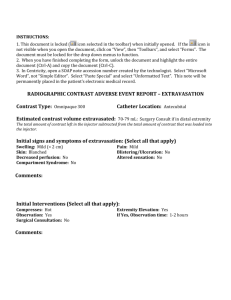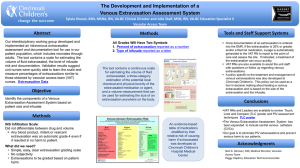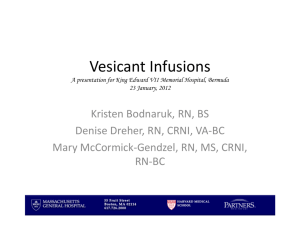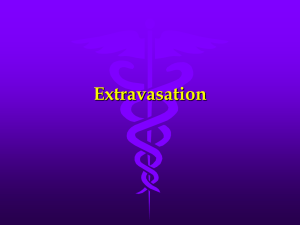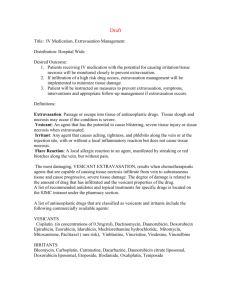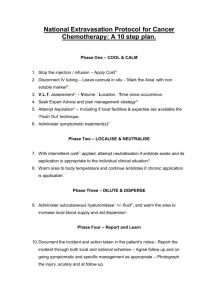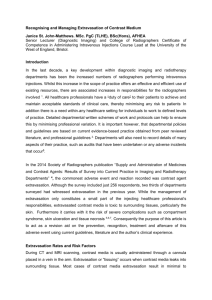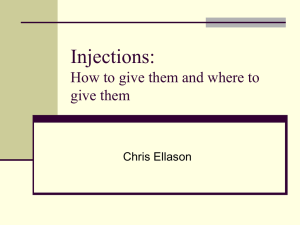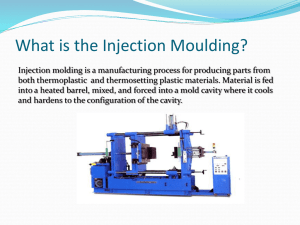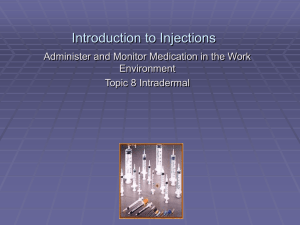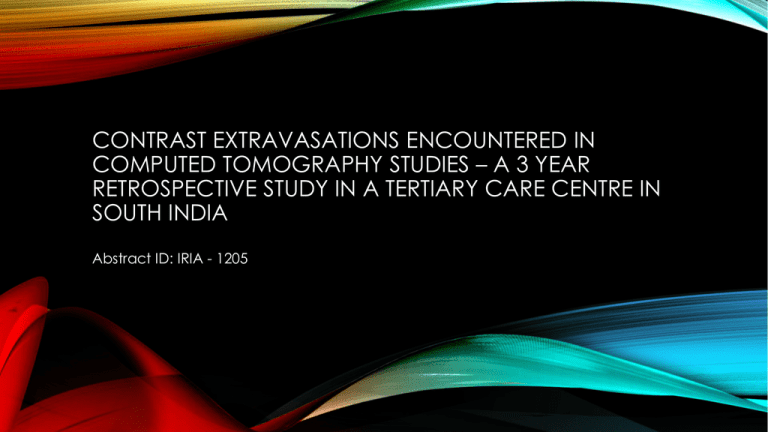
CONTRAST EXTRAVASATIONS ENCOUNTERED IN
COMPUTED TOMOGRAPHY STUDIES – A 3 YEAR
RETROSPECTIVE STUDY IN A TERTIARY CARE CENTRE IN
SOUTH INDIA
Abstract ID: IRIA - 1205
• Aim: To identify the incidence and severity of contrast extravasation
encountered in intravenous iodinated contrast enhanced cross sectional
imaging
• Methodology & materials: 3 years retrospective study from November 2011 October 2014 using data collected from PACS, surgical records, medical
records, audit book in radiology. Clinical severity graded into mild, moderate
and severe according to the clinical findings and outcome.
Materials & methods:
• CT scans were performed on Siemens – Emotion 16, Philips brilliance 6 and GE HD750
• Contrast agents used – Ioversol, Iopamidol, Iodixanol and Iohexol
• Injection method - automatic contrast injector (Imaxeon) or manual injection
• Manual injections were performed when patients were having CT brain, when
patients had poor IV access
• Injection rates - between 0.5 to 6 mL/s depending on individual study requirements.
• Volume - between 40 and 150 mL
Our institution protocol when an event occurs:
• When an event occurs -> Infusion will be stopped immediately -> check the
signs and symptoms -> management either on an OP basis / IP basis
according to the clinical severity -> then following details are recorded:
1. Name
2. Hospital ID
3. Sex
4. Study details (Abdomen, thorax / neck & thorax, angiogram, brain)
5. Date of study
6. Patient is on chemotherapy or not
7. Mode of injection (automatic / manual)
8. Amount of extravasation
9. Treatment given – OP / IP conservative (limb elevation, ice packs,
MgSO4 ointment) / surgery (fasciotomy)
10. Number of days of admission if any
11. Outcome (complete recovery, morbidity, mortality)
Rate of contrast injection given in our department (with pressure injector):
• CT abdomen – 3ml/sec
• CT neck / thorax – 2-3/sec
• CT angiogram – 4-5ml/sec
Pressure used in automatic injector
250-300psi
Volume
• Adult – maximum 2ml / kg
• Paediatric age – maximum 1.5 ml / kg
Results
• Total number of contrast enhanced studies – 69379
• Total number of events – 53
Incidence - 0.08 %
• All the cases were adults
• All of them recovered completely
Mode of injection
Treatment
Surgery - 0
CT Studies
DISCUSSION
• Our observed extravasation rate of 0.08% (53 of 69379 patients) is much less
when compared other series in which automated mechanical injectors were
used, where the extravasation rates ranged between 0.25% and 0.9%
• As in previous series, in our study few of the extravasations involved large
volumes of contrast material.
• Although the most frequently observed range of extravasated contrast
material volumes was 10–40 mL
• In our study, no event occurred in the paediatric age group
• Only 2 extravasations encountered on manual injection, however this was
not taken into account as it was done only for a small number of studies (CT
brains).
• In our institution, we intimate and consult hand surgeons for major cases.
• Most of the patients were conservatively treated and recovered completely
without any residual morbidity like skin ulceration / necrosis
• In this study, the rate of extravasation was more in those patients who were
not on chemotherapy (as it is thought to block the cannula / cause vessel
wall inflammation)
• Majority of the cases were encountered in CT abdomen / pelvis study (rate
of injection – 3ml/sec)
LIMITATIONS
1. It was a retrospective review and was entirely dependent on the quality,
accuracy, and completeness of the extravasation data forms and the
medical records.
2. Some information like injection site, intravenous catheter gauge and
patient symptoms was not provided for a few patients.
3. Follow up was not complete for all of the known extravasations.
CONCLUSION
• Contrast extravasation is a well-known complication of contrast-enhanced
CT scanning and can also occur in MRI studies
Risk factors:
1. Increased incidence with automated power injection because large
volumes can extravasate in a short period of time
• with manual injection, extravasation is thought less likely, as there is direct
supervision of contrast administration
2. Patient-related factors:
•
•
•
•
elderly patients
emaciated patients
oedematous patients
confused patients
Risk factors
3. Site of venous access:
• higher percentage of leakage in the venous access in the dorsum of the hand,
wrist, foot and ankle
• likely related to a smaller amount of subcutaneous tissue and the fact that veins
are more fragile on these regions
4. Gauge of intravenous catheter: over 22G (same for 18G and 20G)
5. High-osmolar contrast medium
Pathology
1. Tissue damage due to direct toxic effect of the agent
2. Increased intra-compartmental pressure in the interstitium over its capillary
perfusion pressure, due to the accumulation of contrast
Capillary blood flow is compromised
Oedema within the soft tissue
increases pressure further
Compromises venous and lymphatic drainage
Worsens
Compromise arteriolar perfusion
Ischemia
Clinical features
Initial signs & symptoms:
- Swelling or tightness
- Stinging or burning pain
- Erythema
Sequelae:
- Compartment syndrome – Intra-compartmental pressure >30 mmHg as an indication
for fasciotomy or pressure <30 mmHg difference between intra-compartmental
pressure and diastolic blood pressure
- Skin ulceration
- Skin necrosis
Evaluation
- Severity and prognosis of a contrast medium extravasation injury are difficult
to determine on initial evaluation of the affected site. Hence close clinical
follow-up for several hours is essential for all patients.
Pressure injectors are indispensable:
1. Tight "Bolus" of Contrast Media – maximum, uniform enhancement and visualization in
the final image without a lot of waste
2. Precise timing of the contrast media delivery
3. Consistent, reproducible, patient-specific results - allows physicians to
easily customize injection protocols for specific studies and specific patients.
4.
Time saving
MANAGAMENT GUIDELINES
Stop infusion, remove the catheter and notify the overseeing radiologist
Conservative measures and inform
hand surgeons
• Limb elevation
• Ice packs
• Mag. Sulphate Ointment
Shift under the care of hand surgeons if there is,
• skin blistering
• altered tissue perfusion
• increasing pain
• change in sensation distal to the site of
extravasation
Worsens
Discharge if there is complete recovery
and no progression for the next 24 - 48
hours
Surgery - Fasciotomy
References:
• Med Princ Pract. 14 (2): 107-10
• ACR Manual on Contrast Media – Version 9, 2013
• Radiology. 2007 Apr;243(1):80-7
• JBR–BTR, 2004, 87 (2)
• J. Nucl. Med. Technol. June 2008 vol 36 no.2 69-74
• Am Fam Physician. 2002 Oct 1;66(7):1229-1235

